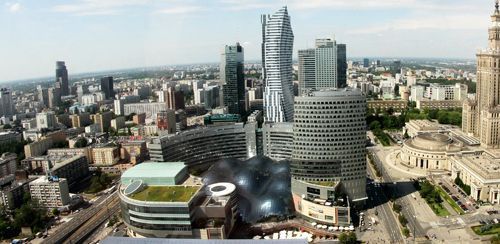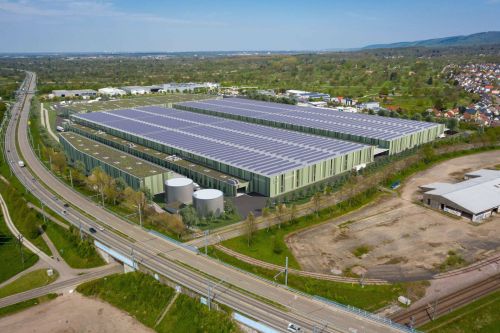25 million square metres on the clock
Feature
If we were to compare the Polish real estate market to a car (unfortunately we cannot compare it to a Polish make), it would probably be a Korean model. In the same way that Asian manufacturers eventually started to compete in terms of the quality and the furnishing of the cars they produced, the Polish real estate market became attractive thanks to its balanced development and the quality of the products offered. Perhaps it is too early to say that we are one of the best brands, but we have already established our position in the ‘value for money’ segment.
From outdoor bazaars to towers of glass
In terms of scale, our country’s real estate scene is dominated by modern retail, which exceeded 10 mln sqm this year. Most of this volume was delivered in the last dozen or so years, since the segment entered the 21st century with only 1 mln sqm of such space completed. The dynamic development of this market since then has established Poland’s position as having one of the largest amounts of retail space in Europe – France has the most with a modern retail area of app. 17.5 mln. Over the same period a significant acceleration was evident in the warehouse sector, bringing the supply of modern industrial space up to today’s level of app. 8 mln sqm. This is all the more impressive when you consider the fact the first modern warehouse in Poland – Warsaw Industrial Center (Distribution Park Okęcie) – was only built in 1995. The office sector started to take off at more or less the same time and now also offers an area of app. 8 mln sqm.
“The commercial real estate market was virtually non-existent in Poland at the end of the 1980s. It only began to emerge at the beginning of the 1990s, following the political changes,” says Tomasz Trzósło, the director of capital markets in Poland and the managing director for Poland at JLL. “Our opening up to foreign capital was the key event, not only for the real estate market but also for the entire economy. It resulted in an influx of funds, but that was not all that came to us. Another crucial import was the knowledge of how to successfully operate in the new market conditions – especially technological and strategic knowledge, which has particularly made an impact on the real estate sector. The influx of such know-how made it possible for the real estate market in Poland to grow dynamically and for local real estate staff to be trained,” adds Tomasz Trzósło. Over the last 25 years we have certainly come a considerable distance. Of course, there is still much that needs to be done to modernise the economy, as is reflected in the GDP level. “Still, in many respects, the real estate sector has managed to outpace the general and economic growth and match Western economies in terms the quality of the methods used (e.g. construction, technical and legal). This is particularly true in the retail sector. We started with outdoor markets and bazaars and now we are in the pole position in Europe, both in terms of the quality and the size of the shopping centre market. It is also worth emphasising that there has been a considerable improvement in the public infrastructure, not only in terms of roads and motorways, but also when it comes to the appearance of urban areas,” adds JLL’s expert.
EU breakthrough
The growth in the amount of modern real estate, naturally, was not linear. There were periods when the market shot up, but there were also others when it slowed down. For example, in the years that immediately preceded EU accession, virtually every property sector experienced a downturn. “EU accession was a milestone for the Polish real estate market, as well as the clear increase in optimism on the global markets,” claims Richard Aboo, a partner and director of the office department at Cushman & Wakefield. “The investment market also boomed after 2004. Poland became a destination for investors from Germany who were looking for safe assets and more aggressive opportunistic players from the UK, the USA and Canada. So far the investment record established in 2006, when over EUR 5 bln was spent on Polish commercial real estate, has not been broken,” adds the Cushman & Wakefield expert. The 2005–2008 period was one of dramatic development for the Polish real estate sector. The demand for new facilities was burgeoning in all segments, while prices were increasing – sometimes reaching extortionate levels – and investor interest in Poland was also on the march. But this real estate extravaganza came to a juddering halt in 2008.
A blessing in disguise
The downturn had arrived, but the shock did not last long. The credit crunch actually brought with it new investment in Poland, particularly on the warehouse and office markets. Western companies were looking for ways of reducing their operating costs and operating on the Polish market turned out to be an ideal way of achieving this. Meanwhile, the interest in shared service centres was growing on office market. Thanks to this, regional cities such as Kraków, Wrocław, the TriCity, Poznań and Łódź could finally spread their wings. The retail market was capitalising on the high local demand. There were some problems, of course, particularly for the residential sector and with the investment market – transactions worth a mere EUR 800 mln were concluded in 2009.
Back in shape
The commercial real estate market showed something of a return to form in 2011, and since 2012 it has been clearly picking up speed. Looking at the present situation, it closely resembles how things were eight years ago. However, there are some significant differences. According to Tomasz Trzósło, the supply of new investment product is still lower than 2006 (the result of reduced development activity) and investors are more cautious than they were when analysing potential acquisitions. Also the banks are not as willing to provide financing. Moreover, the number of funds looking for opportunities on the Polish investment market is not as substantial as it was eight years ago. “As a result, in the near future I do not expect a repeat of the investment market bubble we experienced before the credit crunch. Investors are remaining cautious, which is why we are likely to have a few years of reasonable stability on the market rather than any surge in growth,” predicts the JLL expert. Hadley Dean, the managing partner for the CEE region at Colliers International, is also expecting stability and balanced development. In his opinion the Polish real estate market will continue along its current development path and show more interest in the regions. The logistics market, which is gaining in strength thanks to the emergence of e-commerce, is one that still has very good prospects. This sector should be turning to the development of smaller distribution centres located in towns and cities where demand exists for e-commerce services. The impact of online shopping is also being seen on retail market. “Over the next few years investors will be more interested in reformatting existing buildings to adjust them to the shopping habits of the day, rather than building new ones”, believes the Colliers International expert.
The retail market could also experience some rather high property valuations. Investors have now adopted very selective policies in this respect. “Flagship shopping centres could fetch very high prices, so they do not really need to fear competition from the increasing presence of e-commerce, even though it will certainly have an impact on the future of the Polish retail market. Large, popular centres should be able to maintain their positions, but weaker centres on the market can expect to have to face a lot of new challenges, such as reconfiguration, remodelling their profiles, or repositioning,” suggests Tomasz Trzósło.
Premium class
Thanks to more than two decades of relatively balanced development, the Polish real estate market is the leader in its region and a competitor for Western markets. “There has been a crucial change in the perception of Poland on the investment market, where it is starting to be treated as a Western European economy rather than as a part of Central and Eastern Europe. At the same time yields are at a level that is characteristic for this region. This explains why Poland will remain attractive for investors. I can imagine that within, let’s say, five years yields in Warsaw will be similar to those in the capital cities of Western Europe,” forecasts Hadley Dean. So when it comes to that car, perhaps we should now be thinking of a luxury model rather than a regular family saloon?





















































